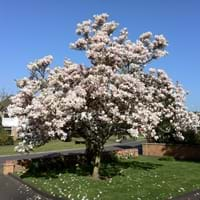What is
Life Span
Perennial
Perennial
Type
Bulb or Corm or Tuber
Tree
Origin
South America, Argentina
Not Available
Types
Not Available
Gwillimia, Manglietia, Kmeria
Number of Varieties
Not Available
19
99+
Habitat
Temperate Regions
Subtropical climates, Tropical regions
USDA Hardiness Zone
5-9
6-9
AHS Heat Zone
9-1
9-6
Sunset Zone
21,22
Not Available
Habit
Clump-Forming
Oval or Rounded
Information
Plant Size
Minimum Height
10.20 cm
99+
460.00 cm
99+
Minimum Width
5.10 cm
99+
370.00 cm
99+
Plant Color
Flower Color
Light Blue, Light Purple, Silver, Sky Blue
Purple, Pink, Light Pink, Rose
Flower Color Modifier
Bicolor
Bicolor
Fruit Color
Not Available
Brown
Leaf Color in Spring
Green, Light Green, Gray Green
Green
Leaf Color in Summer
Light Green
Green
Leaf Color in Fall
Several shades of Green
Green, Yellow green, Sandy Brown
Leaf Color in Winter
Light Green
Not Available
Shape
Leaf Shape
Grass like
Ovate
Thorns
No
Not Available
Season
Plant Season
Spring
Spring, Summer
Growing Conditions
Sunlight
Full Sun, Partial Sun, Partial shade
Full Sun, Partial Sun
Growth Rate
Medium
Medium
Type of Soil
Clay, Loam, Sand
Clay, Loam, Sand
The pH of Soil
Acidic, Neutral, Alkaline
Acidic, Neutral
Soil Drainage
Well drained
Well drained
Bloom Time
Early Spring, Spring, Late Winter
Spring, Late Spring
Repeat Bloomer
No
No
Tolerances
Drought
Not Available
Care
Where to Plant?
Container, Ground
Ground
How to Plant?
By dividing rhizomes, tubers
Seedlings, Transplanting
Plant Maintenance
Medium
Medium
Watering Plants
Watering Requirements
Average Water Needs, Do Not over Water, Requires regular watering
Prefer drip-irrigation instead of Over-head watering
In Summer
Lots of watering
Lots of watering
In Spring
Moderate
Moderate
In Winter
Average Water
Average Water
Soil
Soil pH
Acidic, Neutral, Alkaline
Acidic, Neutral
Soil Type
Clay, Loam, Sand
Clay, Loam, Sand
Soil Drainage Capacity
Well drained
Well drained
Sun Exposure
Full Sun, Partial Sun, Partial shade
Full Sun, Partial Sun
Pruning
Remove damaged leaves, Remove dead branches, Remove dead leaves
Prune if you want to improve plant shape
Fertilizers
All-Purpose Liquid Fertilizer
Fertilize in late fall, fertilize in spring, Requires high amount of nitrogen
Pests and Diseases
Slugs, Snails
Aphids, Bacterial Blight, Canker, Crown gall, Hoplia beetle, Leaf burn, Leaf spot, Mealybugs, Powdery mildew, Red blotch, Scorch, Soft scales, Thripes, Wetwood
Plant Tolerance
Drought
Not Available
Facts
Flowers
Showy
Showy
Flower Petal Number
Single
Single
Fruits
Showy Fruit
No
No
Edible Fruit
No
No
Fragrance
Fragrant Flower
Yes
Yes
Fragrant Fruit
No
No
Fragrant Leaf
Yes
No
Fragrant Bark/Stem
No
No
Showy Foliage
No
No
Showy Bark
No
No
Foliage Texture
Medium
Coarse
Foliage Sheen
Matte
Matte
Evergreen
No
No
Invasive
No
No
Self-Sowing
Yes
No
Attracts
Bees, Birds, Hummingbirds
Not Available
Allergy
Not Available
Not Available
Benefits
Uses
Aesthetic Uses
Showy Purposes
Showy Purposes
Beauty Benefits
Not Available
Treatment of Dark Spots
Edible Uses
No
Yes
Environmental Uses
Air purification
Air purification
Plant Benefits
Medicinal Uses
Not Available
Alzheimer’s Disease, Anxiety, Cancer, Digestion problems, Liver problems, Menstrual Cramps, Respiratory Disorders, Weight loss
Part of Plant Used
Flowers
Whole plant
Other Uses
Not Available
Used as Ornamental plant, Used for its medicinal properties
Used As Indoor Plant
Yes
Yes
Used As Outdoor Plant
Yes
Yes
Garden Design
Container, Lawns and Turf, Mixed Border, Rock Garden / Wall, Wildflower
Feature Plant, Foundation, Shade Trees
Scientific Name
Botanical Name
Ipheion uniflorum
MAGNOLIA 'Alexandria'
Common Name
Spring Starflower, Springstar
Alexandria Magnolia, Magnolia
In Hindi
Spring Starflower
हिम चम्पा
In German
Frühling Borretsch
Magnolienbaum
In French
Spring Starflower
magnolia
In Spanish
primavera Flor de estrella
árbol de magnolia
In Greek
άνοιξη starflower
Magnolia δέντρο
In Portuguese
primavera Starflower
magnólia
In Polish
Wiosna Starflower
magnolia drzewa
In Latin
Spring Starflower
Magnolia lignum
Classification
Kingdom
Plantae
Plantae
Phylum
Magnoliophyta
Magnoliophyta
Class
Lilopsida
Magnoliopsida
Order
Asparagales
Magnoliales
Family
Liliaceae
Magnoliaceae
Genus
Ipheion
Magnolia
Clade
Angiosperms, Monocots
Angiosperms, Magnoliids
Tribe
Gilliesieae
Not Available
Subfamily
Allioideae
Not Available
Number of Species
Not Available
210
99+
|
||
|
||
|












